Photo from the Field: Another Successful Year for Great Bay Terrapin Garden
by Ben Wurst, Habitat Program Manager

by Ben Wurst, Habitat Program Manager

by Ben Wurst, Habitat Program Manager







Over the past several years, I have worked with LBIF to help guide their efforts to provide habitat for wildlife on their property in Loveladies. We have always wanted to establish another, larger “turtle garden” for nesting female N. diamondback terrapins, since they are a common visitor during summer months. This spring we received a small grant from the Garden Club of Long Beach Island to establish a new turtle garden at LBIF. Late last month we ordered 15 tons of mason sand from a local supplier, which provides excellent nesting habitat, with small grain size and little organic matter. Myself and Jeff Ruemeli, who is the new Director of Sciences at LBIF, worked to install coir logs to hold the sand before spreading it out by hand. I followed up with planting around 30 seaside goldenrod plants at the site to help stabilize sand and provide foraging habitat for pollinators.
Continue reading “Photos from the Field: Giving LBIF’s Terrapins a Boost!”by Ben Wurst, Habitat Program Manager

By now, most people who live along the coast of New Jersey have seen an osprey. They have returned to claim their waterfront homes and spruce them up. April is the season of upside-down osprey (more on this in a few), and for those who haven’t seen an osprey, then you should tune in to the drama unfolding at the Barnegat Light Osprey Cam! Both a male and female have returned to the BL Osprey Cam nest, but only the female (Daisy) is the same as last year. There have actually been several males seen on the nest so far and just this morning, two confronted each other above the nest!
Continue reading “They’re Back: Barnegat Light Ospreys!!”by Ben Wurst, Habitat Program Manager
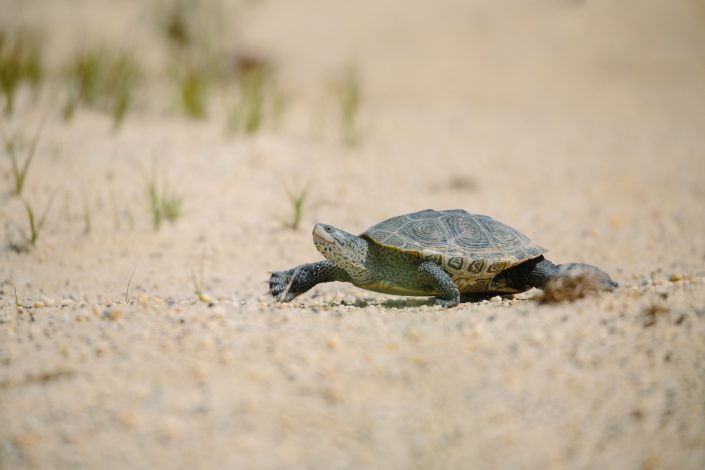
As with many of our conservation projects, they are centered around compassion for a species in need. One of which is the northern diamondback terrapin: a coast hugging turtle who inhabits salt marsh habitat from Cape Cod to Cape Hatteras. In New Jersey they range from the Meadowlands south along the coast and in the Delaware Bay. Terrapins are known to have a very small home ranges and some may inhabit the same small creek for their entire lives. During summer months, females leave the protection of their salt marsh habitat to seek out sandy nest sites above the high tide line. Many times, they encounter a roadway and the results can be deadly.
Continue reading “Build it and they will come”by Ben Wurst, Habitat Program Manager
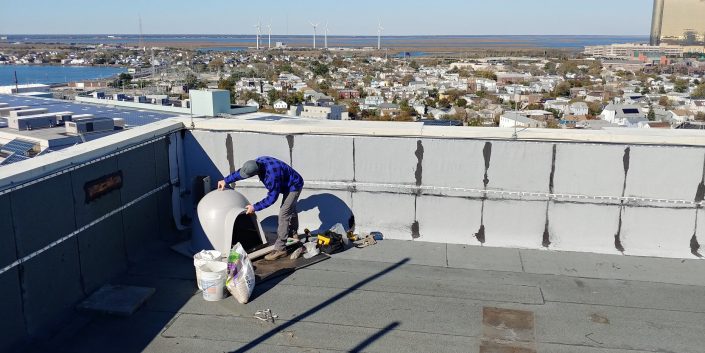
This past week I had the pleasure of assisting Supervising Zoologist, Kathy Clark with NJ Fish & Wildlife’s Endangered and Nongame Species Program to install a new nestbox for state endangered peregrine falcons. The new nestbox was installed atop the Sheraton Atlantic City Convention Center Hotel. Peregrine falcons are not new to Atlantic City. They have nested in A.C. since 1987, where the first pair nested on the 23rd floor of the Hilton/Atlantic Club. Since then new pairs have established nests on other tall buildings and structures, like the Hard Rock Casino and A.C. water tower.
Continue reading “Photos from the Field: Falcons rule the roost at Sheraton Hotel in AC”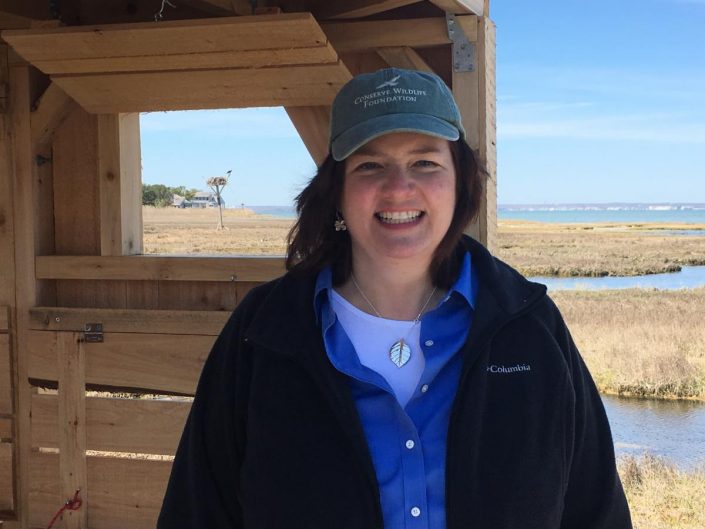
The Board of Trustees of Conserve Wildlife Foundation of New Jersey (CWF) is pleased to announce the appointment of Liz Silvernail to Executive Director. In this role, Silvernail will guide the organization in its work to preserve rare and at-risk wildlife in New Jersey through field science, habitat restoration, public engagement, and education.
“I am honored to have this opportunity to lead CWF as executive director,” said Silvernail. “With the support of our dedicated and hard-working biologists, the leadership of our board, and the commitment of our supporters and volunteers, we’re ready to take on the daunting challenges facing our rare wildlife and the habitats on which they depend.”
A part of CWF for nearly 12 years, Silvernail was most recently Acting Executive Director. Previously, she was Director of Development where she formed strong corporate and donor partnerships to build organizational capacity and impact. Through her leadership, CWF developed and implemented highly successful STEAM educational programs throughout New Jersey schools as well as the annual Women & Wildlife Awards and a host of outreach initiatives to promote public awareness of at-risk wildlife.
“Liz is uniquely qualified to lead CWF in the implementation of our strategic plan,” stated Steve Neumann, President of the Board of Trustees for CWF. “Her passion for environmental causes, depth of experience, vision and collaborative approach will be instrumental in our partnerships and donor support.”
Silvernail brings over 30 years of non-profit experience to the role. Prior to joining CWF, she championed environmental advocacy for both Scenic Hudson and NJ Keep it Green. A graduate of Boston College, she serves on the board of EarthShare New Jersey and has volunteered with the Garden Club of America, Junior League of Greater Princeton, and Girl Scouts of Eastern Pennsylvania.
Amy Greene of Amy Greene Environmental and a CWF Trustee offered, “Liz’s deep understanding of the organization’s mission, her strong relationship with CWF and NJDEP staff and donors, her commitment to restoring New Jersey’s rare species populations, and her compassion for educating its human inhabitants about the importance of rare species protection makes her a natural to lead CWF to continue to help New Jersey’s most threatened wildlife thrive.”
>> Learn more about Conserve Wildlife Foundation of New Jersey
by Ben Wurst, Habitat Program Manager
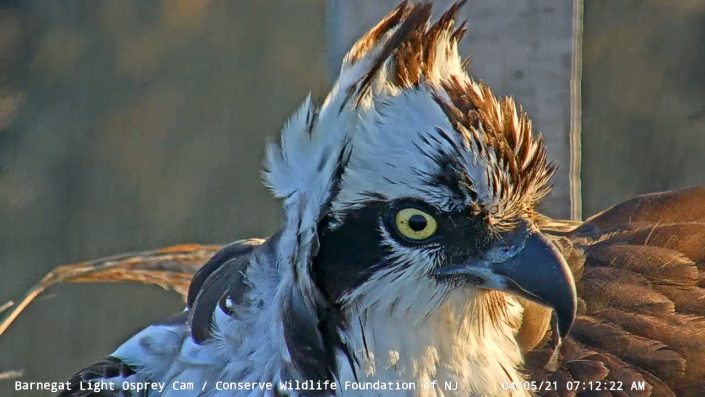
By far, this was the most viewed season of the Barnegat Light Osprey Cam, with over 360,000 views and 111,000 hours watched! It was a season of change. Viewers throughout the world watched as the mated pair successfully fledged two healthy young. We witnessed the trials and tribulations of a new pair, especially the female, who we believe attempted reproduction for the first time in her life. We saw that life as a young osprey was not always guaranteed, which is something we rarely get to witness but know is quite common at many nests throughout the world; however, with an experienced male and plentiful prey, the surviving young thrived. As we work on a season long highlight video, here is a brief summary of their nesting season.
Continue reading “Two are sometimes better than three”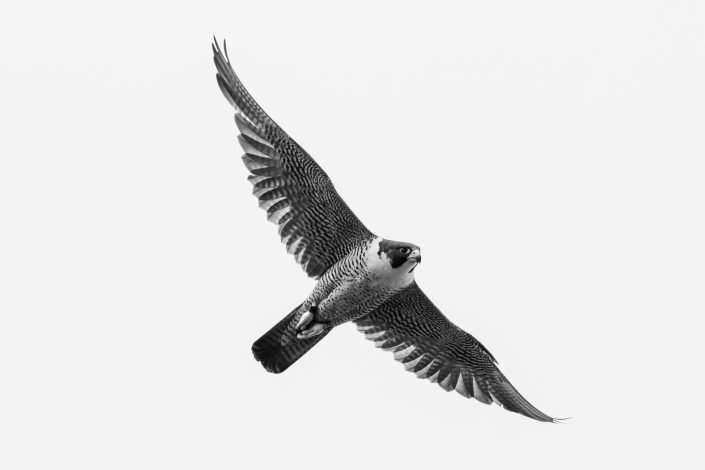
Just imagine having to defend your home from an invader who wants to steal your home and mate. All you have to protect yourself and home are your bare hands (or talons). You fought this same battle several years ago and staked your claim here. It was a hard won battle that could have been the end.
Continue reading “Survival of the Fittest Falcons”by Ben Wurst, Habitat Program Manager
During the peak of my field season last year I exchanged emails with a kind man who reported terrapins nesting in his yard. He wanted to do everything he could to ensure their success. A couple weeks later Bobby reached out to say how much him and mom loved the Barnegat Light Osprey Cam and how “the birds generally wake her up before her alarm.” He also mentioned how she delayed gardening because “dad is due with a fish any minute now. I’m just waiting to note the time then I’ll go play.” She was contributing observations of prey deliveries for research we conducted at the BL Osprey Cam last summer.
Continue reading “A Tribute to Bobby “Twist” Jetton: 2020 Barnegat Light Osprey Cam”by David Wheeler
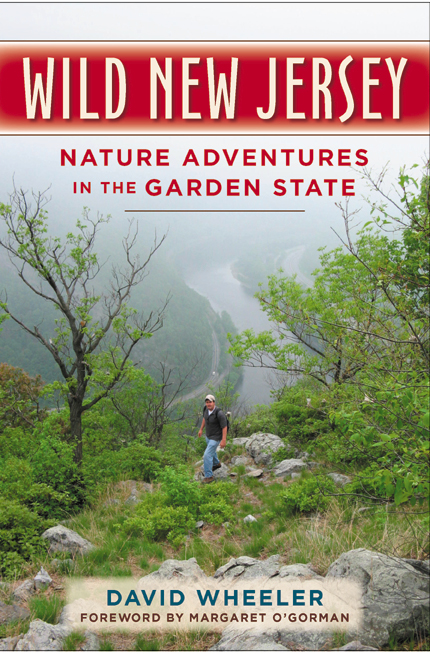
Growing up in suburban and coastal New Jersey, I was fascinated by wildlife from my earliest days. Whether catching frogs in the neighborhood, or collecting safari cards and watching Nature specials on Komodo dragons, wildlife both local and global captured my imagination like nothing else. My studies and early career focused on other areas, such as writing and communications, but the great outdoors was never far from my thoughts.
When the time was right, I decided to write what would become my book, “Wild New Jersey: Nature Adventures in the Garden State.” I spent time with many of the top scientists and naturalists in the state, as I devoted all my free time for a year to undertaking a whirlwind journey around New Jersey, experiencing its wildlife, nature destinations, and outdoor activities first-hand.
It has now been 10 years since “Wild New Jersey” was published. In those ensuing years, I became the Executive Director of Conserve Wildlife Foundation, the dynamic organization that had featured so prominently in my book. Many themes I covered then resound even more today. The across-the-board impacts of climate change on New Jersey’s wildlife. Escalating land development, particularly in suburban areas. An even greater emphasis on protecting wildlife corridors and contiguous habitat. An increasing awareness of many species thriving in urban areas against daunting odds.
For better or worse, the populations of most of New Jersey species I highlighted 10 years ago have continued on the same trends of recovery or decline. That’s good news for bald eagles, peregrine falcons, and ospreys, along with bobcats and coyotes. It’s more worrisome for many bat, amphibian and reptile species, as well as many songbirds, shorebirds, and pollinators.
Sadly, a few of the wildlife pioneers and conservation heroes with whom I was privileged to spend time or enjoy conversations while writing my book have since passed away, including field biologist Charles Kontos, Len Soucy, founder of the Raptor Trust, and Dery Bennett, founder of American Littoral Society. Their legacies carry forward today as strong as ever.

With our past year marked by serious restrictions on both our interaction with others and the activities we can enjoy, many New Jerseyans may have a building list of adventures that we are considering once safety permits. Thankfully, these options haven’t changed much at all over the 10 years since I wrote “Wild New Jersey.” With the right timing and guides, we still can go out and enjoy dog sledding, birding on the open ocean, mountain hikes in bear country, and nighttime treks through a cranberry bog – or, on the more serene side, pontoon boat wildlife tours, river floats, seining, and bird walks led by top experts.
Those kinds of adventures are still out there for the taking in every corner of the state. Some of it can be done right now, while other trips may have to wait until we get further along in our fight against COVID-19.
In the meantime, I am excited to celebrate 10 years of Wild New Jersey with you. For the next year, Conserve Wildlife Foundation will run a seasonal excerpt each month, along with updated commentary giving context to a featured species, habitat, or locale.
Join me on Friday in kicking off our series with a book excerpt and update on the unlikely return of a predator to New Jersey’s wilds.
David Wheeler is the Executive Director of Conserve Wildlife Foundation and the author of Wild New Jersey: Nature Adventures in the Garden State.